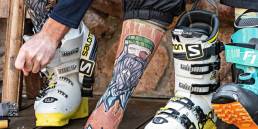Wax on, Wax off – 5 Reasons to Wax your boards, greenicewax. Most ski and snowboard racers understand the importance of prepping their equipment; however, some recreational skiers feel that this process is not critical. All skis and snowboards require some sort of waxing after a few days of skiing or riding. In the current market, there are a variety of options available when it comes to tuning and waxing products. You can spend the time and money required to take your equipment to the local ski shop, or you can prep the equipment yourself. Waxing yourself is less time-consuming, self-gratifying and simple. Basically, there are two types of waxing techniques: iron-on and rub-on. Most racers and serious skiers prefer ironing the wax onto the base as it tends to penetrate into the ski base, providing longer lasting performance and protection. This process requires the purchase more equipment such as irons, scrapers and a series of brushes. Another technique is rub-on. This process is less expensive and simple to do. The wax is applied directly to the base of the ski or board without adding heat, then rubbed in with a cork, and finally buffed smooth with a rag. The downside is that the base does not get penetrated with wax and it does not usually last as long, but the simplicity of the process allows for the wax to be applied as many times as desired throughout the course of the day.
Why should you wax your ski or board?
1. Wax reduces friction between the base of the ski or board and the snow. Reducing friction allows for your skis or board to glide faster, which in a competitive event could mean the difference between a win and a loss. As mentioned before, most racers prefer ironing the wax on the ski base over the rub-on procedure. Green Ice Ski Wax manufactures two non-fluorocarbon race waxes in addition to the traditional hydrocarbon wax. These waxes have proven to be fast and long-lasting, reducing friction between the skis and the snow without the negative health and environmental effects of waxing with fluorocarbon waxes.
2. Ski and board bases are constructed of plastics. All plastics can dry out as plasticizers (chemicals that keep plastics soft and flexible) can leach out over time. As the plasticizers dry out, the base can turn white and chalk. If this happens, the base becomes more brittle and can eventually crack under the constant pressure of carving turns while skiing and riding. Waxing periodically can prevent the drying out of the ski base, helping to give the equipment a longer life.
3. Wax penetrates and protects the base, keeping it coated and lubricated so the friction of riding does not wear the base, but instead wears the wax. Wax can be replaced easily while the ski or board base can only be replaced with the purchase of new equipment.
4. Snow can acquire dirt as particles from trees or chemicals in man-made snow accumulate on the trails. After riding or skiing a day in dirty snow, the bases become dirty themselves. Waxing helps clean the base and prevent sticking. The dirt particles in the snow also rub harshly on the base, speeding up the wear process.
5. Top Ski and Snowboard Pros such as Chris Davenport and Nate Holland swear by it and have their signature wax lines.
Green Ice Ski Wax manufactures and sells both rub-on and iron-on waxes at a variety of performance levels. All Green Ice Ski Wax products are environmentally-friendly. The iron-on waxes are safe to apply and long-lasting. The rub-on wax is made from organic, renewable raw materials, making it 100% biodegradable.
Check out Green Ice Wax (www.greenicewax.com)




